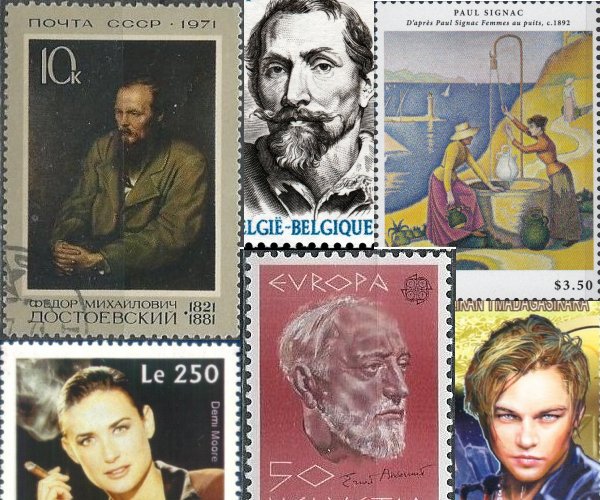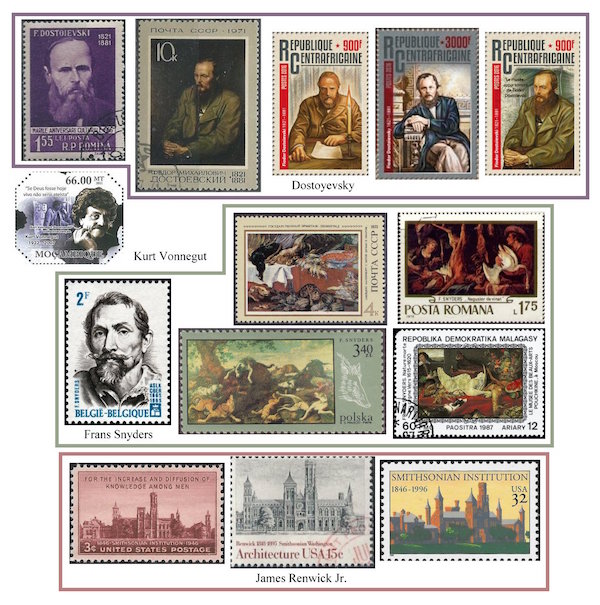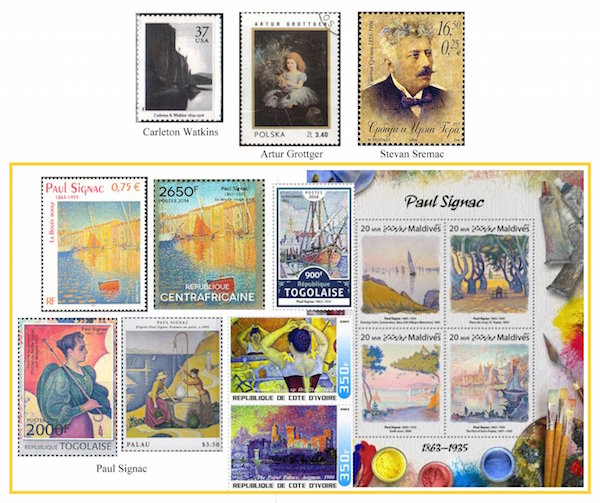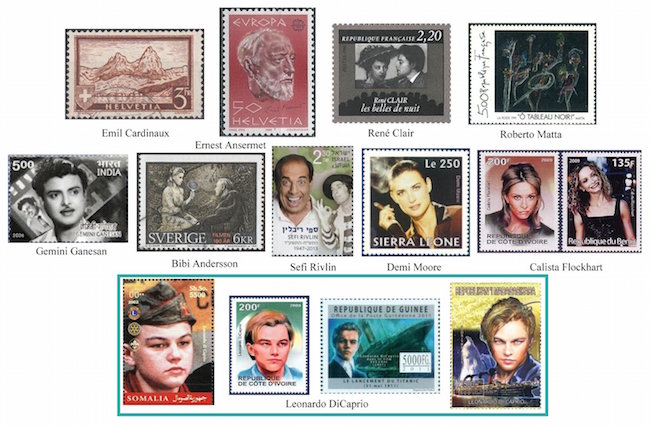The Arts on Stamps of the World — November 11
An Arts Fuse regular feature: the arts on stamps of the world.

By Doug Briscoe
Given the profusion of Soviet and Russian stamps for Tolstoy, Gorky, and others, it surprises me to find only one for Dostoevsky. There’s also a Romanian one, and the others here are drawn from two sheets issued by the Central African Republic. The writings of Fyodor Mikhailovich Dostoyevsky (11 November 1821 – 9 February 1881) have given us any number of film adaptations and at least four classical scores: the novel The House of the Dead was made into an opera by Leoš Janáček; the novella The Gambler was brought to the operatic stage by Prokofiev; Weinberg wrote an opera on The Idiot in 1985; and a versifying character from The Devils (or The Possessed) gave us the “Four Verses of Captain Lebyadkin” set by Shostakovich as his Op. 146.

Dostoevsky shares a November 11 birthday with another writer, Kurt Vonnegut Jr. (November 11, 1922 – April 11, 2007). The story of his experiences in World War II is well known, thanks in large part to his own fictionalization of it in Slaughterhouse-Five (1969). After the war, Vonnegut started a family and settled on Cape Cod. He opened the first Saab dealership in the United States. It failed. He had written some pieces for magazines before his first novel, Player Piano, appeared in 1952. A baker’s dozen of novels followed, along with five plays and many shorter pieces. IMHO, Vonnegut deserves a stamp from the US, but for now he’ll have to make do with one from Mozambique.
Flemish painter Frans Snyders (or Snijders, 11 November 1579, Antwerp – 19 August 1657) was born in Antwerp and was believed to have studied with Pieter Brueghel the Younger. He was in Italy in 1608-09. On his return he married the sister of Cornelis de Vos and undertook some collaborative paintings with Rubens. Most of Snyders’s work depicts still lifes, with animal carcasses prominent, along with hunting scenes, etc. The picture of him seen on the Belgian stamp is derived from a portrait of him and his wife Margaretha by Anthony van Dyck. To the right of the still life on the 1973 Soviet stamp is The Game Merchant on one of Romania, and beneath them are a Wild Boar Hunt on a Polish issue and, from the Malagasy Republic, Still life with a Swan (1640s).
One of America’s most successful architects was James Renwick Jr. (November 11, 1818 – June 23, 1895), who gave us the Smithsonian Building (1847-55), St. Patrick’s Cathedral in New York (1858-79), and the Main Building of Vassar College (1861-65). Of these and numerous churches and other structures he created, mostly for his native New York, only the Smithsonian appears on stamps and does so three times, in 1946, 1980, 1996. His name appears on only one of these, the stamp from 1980 being part of a set honoring American architecture.
American photographer Carleton Watkins (1829 – 23 June 1916) was born in upstate New York and went with a friend to San Francisco in 1851 to pan for gold. They failed in that but succeeded greatly in other ways, Watkins as a photographer and his chum as a railroad owner. Watkins’s introduction to his art was fortuitous, as he happened to work as a clerk near the studio of a Daguerreotypist and found a job in that office. By 1858 he was ready to go off on his own. In 1861 he traveled with his equipment, which included a mammoth-plate camera (which used 18×22 inch glass plates), to Yosemite. The photographs he took there in the years to come would help pave the way for the national park system. Well before Theodore Roosevelt’s day, Abraham Lincoln signed a bill in 1864 preserving Yosemite “for public use, resort and recreation.” Watkins experienced great reverses in his later life—he lost his business and all its contents to a creditor, started going blind in the 1890s, had to live in an abandoned railroad car with his wife and children, and, perhaps worst of all, lost the bulk of his work in the San Francisco earthquake of 1906. His mind failed some time after that, and he lived the last six years of his life in the Napa State Hospital for the Insane. The Watkins photo seen on the stamp is of Cape Horn, Columbia River.
Polish painter Artur Grottger (November 11, 1837 – December 13, 1867) was another victim of tuberculosis and lived to be only 30. He was born in Eastern Galicia and began studying painting in Lwów at the age of 11. He progressed to the Academy in Vienna (1855-58) and didn’t return to Poland until 1865 in the wake of the failed January Uprising. A consequence of this debacle was Grottger’s several series of black-and-while panels depicting decisive moments in the history of Poland’s insurrections: Warszawa (two cycles, of which the second is now housed in the Victoria and Albert Museum), Polonia, Lithuania, and Wojna (1863-67). (These links show the complete cycles, but with text in Polish only). He devoted much time and effort and expertise to these works without financial reward. But another artistic monument owes its existence to them: in 1908, Ignacy Jan Paderewski (whose birthday is one week away), finished his grandest score, the Polonia Symphony, inspired by the eponymous series of pictures by Grottger. Most of Grottger’s work was of battle scenes, horses, and portraits, one of which, Portrait of Rozalia Matylda Glaser, is shown on the Polish stamp. Grottger’s last painting was his Self-Portrait (1867).

Serbian writer Stevan Sremac (11 November 1855 – 13 August 1906) is best remembered as a humorist. After the deaths of his parents, he went to university in Belgrade and served with the Serbian Army between 1876 and 1878. In that year he was graduated with degrees in philosophy and history and turned to teaching, which profession he practiced for the rest of his life, dearly loved by his students for his tenderness and geniality. It wasn’t until 1890 that his writing, beginning with novels based on Serbian history but concentrating on the lives of simple folk, began to make its mark. Much of this matter later found its way into dramatizations on stage and in numerous films, and example being Ivkova slava (Ivko’s Feast, 2005), after the novel of 1895. Sremac died at 50 of accidental blood poisoning.
We have many stamps for the French Neo-Impressionist painter Paul Signac (11 November 1863 – 15 August 1935), probably the most important Pointillist after Georges Seurat (birthday early next month). Signac, a Parisian, studied architecture before turning to painting on seeing an exhibit of the work of Monet (birthday in three days). He met both the above-named artists in 1884. Signac loved sailing and painted many watercolors of harbors and landscapes in France and elsewhere. One such is La bouée rouge (The Red Buoy, 1895), chosen for stamps from France and the Central African Republic. Keeping to our theme, we see The Port (detail, 1923), and on the left side of the minisheet from the Maldive Islands Evening Calm, Concarneau, Opus 220 (Allegro Maestoso) (1891) and Golfe Juan (c1896). On the right side of the sheet we have Plane Trees, Place des Lices (1893) and The Port of St-Tropez (1901-02). In the next row are Woman with Umbrella (Femme à l’ombrelle, 1893), Women at the Well (Femmes au puits, c1892), Woman Taking Up Her Hair (1892), and The Papal Palace, Avignon (1900).
Swiss painter and poster designer Emil Cardinaux (11 November 1877 – 2 October 1936) was born and died in Bern. He studied there and in Munich, returning to Bern in 1903. He also illustrated books and drew caricatures, and so on. We have a 1931 Swiss stamp that uses one of his designs showing one of his characteristic images, the Grosser Mythen mountain peak in central Switzerland.
Another Swiss, the conductor Ernest Ansermet, was born on November 11, 1883. He started his career as a math professor. He took up conducting at Montreux in 1912 and from 1915 to 1923 was conductor for the Ballet Russes, with whom he had some of his most significant historical successes. In 1918 he founded L’Orchestre de la Suisse Romande, with which he made recordings well into the stereo era. In fact, he and the OSR were the first (1954) to make commercial stereo recordings in Europe. He was one of the first classical musicians to appreciate jazz and wrote an article in praise of Sidney Bechet in 1919. Besides a few compositions of his own, including piano pieces and a symphonic poem, Feuilles de Printemps (Leaves of Spring), he orchestrated Debussy’s piano work Six épigraphes antiques. Ernest Ansermet led the premières of half a dozen works by Stravinsky (Histoire du soldat, Pulcinella, Renard, Les noces, Capriccio, and Mass), as well as Manuel de Falla’s Three-Cornered Hat, Prokofiev’s Chout, and Britten’s Rape of Lucretia. He died on 20 February 1969 in Geneva at the age of 85.

Also born on November 11 was French filmmaker René Clair (1898 – 15 March 1981). Parisian born as René-Lucien Chomette, he served in World War I as an ambulance driver and suffered a back injury. He wrote a volume of poetry about his experiences in the war, but it was not published. Instead he worked as a journalist and during a visit to film studios found himself being asked to act. It was at that time that he took on the stage name René Clair. He directed his first short film in 1924 and was asked to provide one as part of the scenery for Erik Satie’s ballet Relâche. In his succeeding films, Clair not only directed, but wrote his own scripts and edited the films. He made three of them in London in 1935-38 and four in the United States (1941-45), of which the most famous, if least characteristic, was probably And Then There Were None (1945). Clair made eight more features in France between 1947 and 1965, one of them being Les Belles de nuit (1952), featured on the stamp.
Next we come to the Chilean abstract expressionist and surrealist painter Roberto Matta (November 11, 1911 – November 23, 2002). Born in Santiago, Matta studied architecture and interior design and went into his country’s merchant marine, thus seeing Europe for the first time. He received encouragement from André Breton. When Matte emigrated to the United States in 1938 he turned from drawing to oils. He remained in America for a decade; his departure in 1948 may have been connected with accusations that his relationship with Arshile Gorky‘s wife had been the reason for that artists’s suicide. Back in Chile, Matta was a strong supporter of the socialist government of Salvador Allende. Following Allende’s ouster, Matta’s huge mural The First Goal of the Chilean People (1971) was covered with 16 coats of paint on the orders of Augusto Pinochet, but the mural was fully restored in 2008, six years after Matta’s death. The French stamp gives us the artist’s Ô tableau noir!
All the rest of today’s subjects are movie people. Swedish actress Bibi Andersson (born Berit Elisabeth Andersson on this day in 1935) worked extensively with Ingmar Bergman, beginning in 1951, when she appeared in a TV commercial he produced for a detergent. Bigger and better things were in the offing, among them The Seventh Seal, Wild Strawberries (from which she is seen on the stamp opposite Victor Sjöström), The Passion of Anna, and Persona. She was also affiliated with the Royal Dramatic Theater in Stockholm for 30 years. In the US she made her debut in a stage production of Erich Maria Remarque’s Full Circle in 1973. Later she became a theater director in Stockholm. Andersson suffered a massive stroke in 2009 and, as I gather, remains hospitalized. She wrote an autobiography in 1996.
Israeli actor and comedian Sefi Rivlin (November 11, 1947 – December 3, 2013) began on the stage in 1973, but is best known for his work in television. He played the Archie Bunker character on the Israeli version of All in the Family and a Mr. Bean knockoff on a series called simply Sefi. He also worked on children’s programs and returned to the stage as well as making some movies in the 1980s and 90s.
American movie stars have we three: Demi Moore (born Demi Gene Guynes on November 11, 1962), Calista Flockhart (1964), and Leonardo DiCaprio (1974) are all represented on stamps, whereas to the best of my knowledge Stanley Tucci (1960) is not.
Another surprise in the No-Show Department is Mexican novelist Carlos Fuentes (November 11, 1928 – May 15, 2012).
A graduate of the University of Massachusetts with a B.A. in English, Doug Briscoe worked in Boston classical music radio, at WCRB, WGBH, and WBUR, for about 25 years, beginning in 1977. He has the curious distinction of having succeeded Robert J. Lurtsema twice, first as host of WGBH’s weekday morning classical music program in 1993, then as host of the weekend program when Robert J.’s health failed in 2000. Doug also wrote liner notes for several of the late Gunther Schuller’s GM Recordings releases as well as program notes for the Boston Classical Orchestra. For the past few years he’s been posting a Facebook “blog” of classical music on stamps of the world, which has now been expanded to encompass all the arts for The Arts Fuse.
